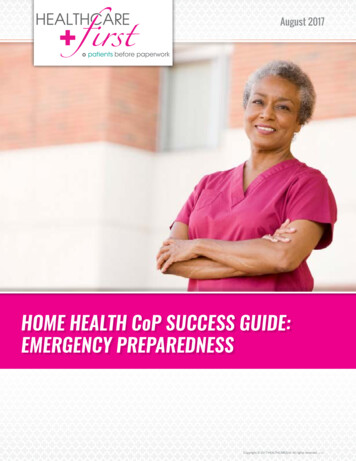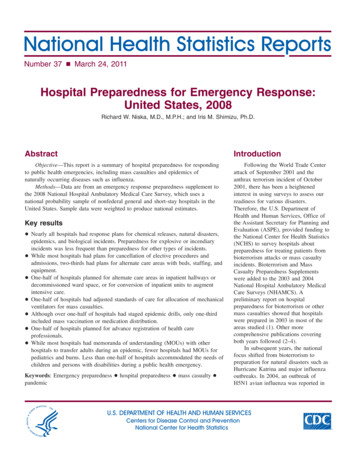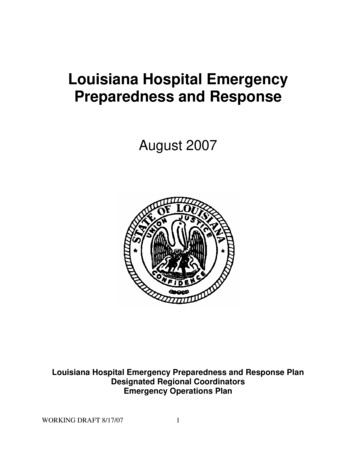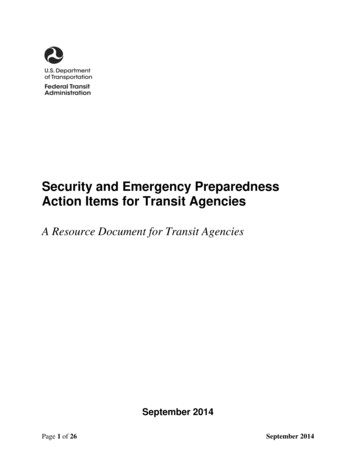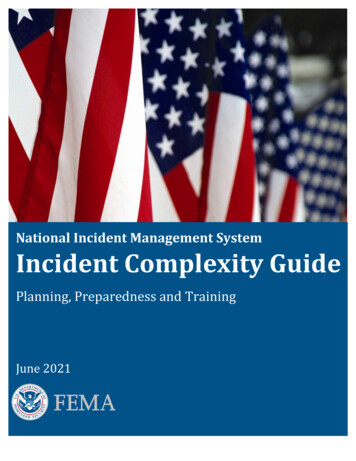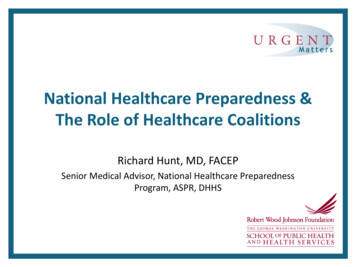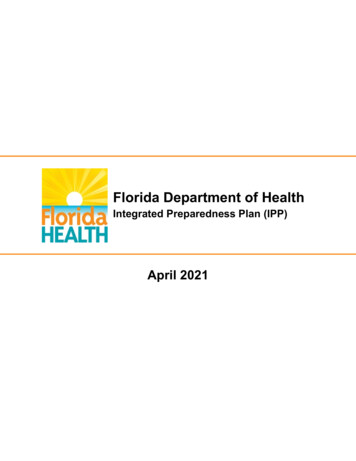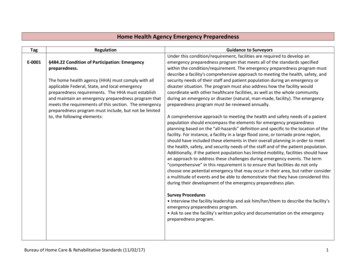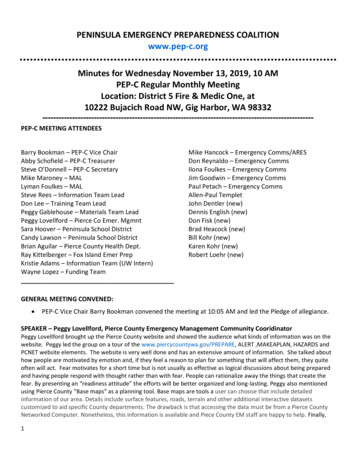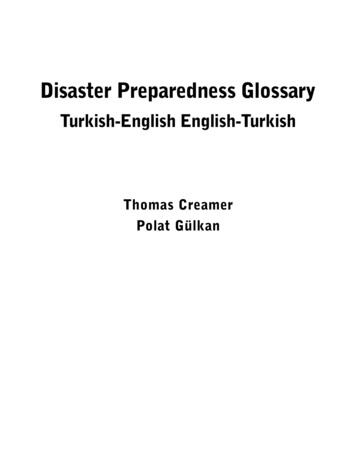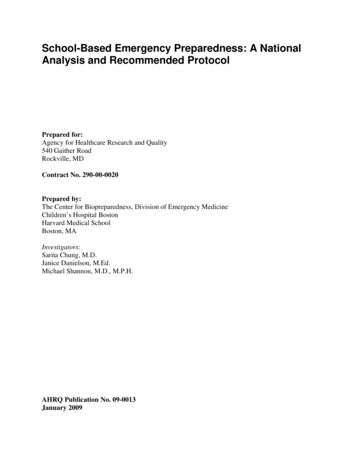
Transcription
School-Based Emergency Preparedness: A NationalAnalysis and Recommended ProtocolPrepared for:Agency for Healthcare Research and Quality540 Gaither RoadRockville, MDContract No. 290-00-0020Prepared by:The Center for Biopreparedness, Division of Emergency MedicineChildren’s Hospital BostonHarvard Medical SchoolBoston, MAInvestigators:Sarita Chung, M.D.Janice Danielson, M.Ed.Michael Shannon, M.D., M.P.H.AHRQ Publication No. 09-0013January 2009
School-Based Emergency Preparedness: A National Analysis and Recommended Protocol wasproduced under a U.S. Department of Health and Human Services’ Agency for HealthcareResearch and Quality (AHRQ) contract (Contract No. 290-00-0020).The authors of this report are responsible for its content. No statement in the report should beconstrued as an official position of the U.S. Department of Health and Human Services or theAgency for Healthcare Research and Quality.This document is in the public domain and may be used and reprinted without permission exceptthose copyrighted materials noted for which further reproduction is prohibited without specificpermission of copyright holders.Suggested Citation:Chung S, Danielson J, Shannon M. School-based emergency preparedness: a national analysisand recommended protocol. (Prepared under Contract No. 290-00-0020.) AHRQ Publication No.09-0013. Rockville, MD: Agency for Healthcare Research and Quality. December 2008.ii
ContentsPart I: Creation of a School-Based, All-Hazards Emergency Response Plan: Overview,Background, and RecommendationsExecutive Summary .1Introduction .3Recommendations 5Conclusions .13Resources 15Part II: The Brookline Schools Project: A Roadmap to Creating a Comprehensive SchoolEmergency Response PlanBrookline School System Characteristics .19National Review of School Emergency Response Plans .19Introduction of the Project to Town Stakeholders .21Information Gathering, Findings .21Unresolved Challenges in the Brookline Emergency Response Plan .24Recommendations and Feedback .25Tabletop Exercises .28Education and Training of School Nurses .28Creation of an Emergency Response Manual and Handbook .28Creation of a Final Report to the Brookline Public Schools .29Conclusion 29AppendixesAppendix A:Appendix B:Appendix C:Appendix D:Appendix E:Appendix F:Table – National Analysis of School Emergency Response Plans .31Needs Assessment Survey Forms .33Principal Interview Questions .41Extended Day/After-School Programs Director Interview Questions .43Tabletop Exercise Resources. .45Annual School Emergency Preparedness Summary Form .47iii
Part I. Creation of a School-Based, All-HazardsEmergency Response Plan: Overview, Background,and RecommendationsExecutive SummaryMore than seven years after the disaster of September 11, 2001, the U.S. remains relativelyunprepared for a large-scale disaster involving children. Despite important advances in ourcountry’s ability to respond effectively to chemical, biological, or nuclear terrorism, therecontinues to be inadequate development of pediatric protocols that could be implemented by thelocal, State, and Federal agencies charged with preparation and consequence management.Emergency preparedness plans have evolved over recent years to include not only intentional(terrorist) disasters but also unintentional public health emergencies such as natural disasters(e.g., earthquakes or floods; chemical incidents such as hazardous materials releases; andemerging infections such as Severe Acute Respiratory Syndrome (SARS), West Nile virus, andpandemic influenza). Under principles of dual functionality, emergency response plans must nowtake the approach of creating response plans that integrate intentional and unintentional disasters.Children differ from adults in many ways that are of great importance in building public healthemergency response plans. Their greater susceptibilities result from differences in breathing rate,skin permeability, innate immunity, fluid reserve, communication skills, and self-preservationinstincts. These differences and others require that disaster response plans be modified for such apriority population.Children also spend as much as 70-80 percent of their waking hours away from their parents inschool. Schools, therefore, have a vital role in assuring that children are cared for and properinterventions are delivered after a public health emergency. When this project was undertaken in2004, there was no national model for school-based public health preparedness. Consequently,school districts across the Nation had rudimentary, fragmented, or non-existent emergencypreparedness programs. Since 2006, there has been a marked increase in awareness of thevulnerability of schools and the challenging logistics involved in protecting children in schoolsduring unexpected events. However, there continue to be obstacles for many school districts increating a practical, comprehensive, and practiced school-based emergency response plan.Among these obstacles are evacuation, accommodations for children with special health careneeds, and inclusion of after-school programs in emergency response plans.Under a contract from AHRQ, the Center for Biopreparedness at Children’s Hospital Bostonconducted an analysis of emergency response plans from school districts in Massachusetts,Florida, Wisconsin, Colorado, and California. Using these findings in conjunction with existingrecommendations on the development of school-based preparedness programs, we developed atemplate that provides an overview, including “best practices” for school districts to use in theirdevelopment of a comprehensive emergency response plan. Finally, in cooperation with theBrookline, Massachusetts, public schools, we designed a roadmap for the development of1
school-based plans for each of the eight elementary schools, high schools, preschools, and afterschool programs in Brookline.This monograph provides guidelines for use by school districts of all sizes. Our goal in creatingthis monograph is to describe to readers a practical approach to creating a school-based allhazards emergency response plan from the national literature in combination with “lessonslearned” in the field.Sarita Chung, M.D.Janice Danielson, M.Ed.Michael Shannon, M.D., M.P.H.August 2008Dr. Sarita Chung is a project scientist at the Center for Biopreparedness at Children's Hospital,Boston, MA. She is a pediatric emergency physician at Children's Hospital, Boston, MA, andHarvard Medical School.Janice Danielson is an elementary school teacher with 25 years experience in kindergarteneducation. She currently serves as a consultant in school-based emergency preparedness.Dr. Michael Shannon is Director of the Center for Biopreparedness at Children’s Hospital,Boston, MA. He is Professor and Chief emeritus of the Division of Emergency Medicine atChildren’s Hospital and Harvard Medical School.2
IntroductionTerrorism and Disasters – An OverviewOn September 11, 2001, the U.S. was victim of an unprecedented terrorist attack. This wasfollowed within a month by the intentional release of anthrax spores placed in tainted letters.These two events permanently altered the American way of life. Among the lessons learned inthese and subsequent terrorist events is that domestic terrorism exists as a new part of society;gone are the days when terrorism and the release of weapons of mass destruction were focusedsolely on the military theater.Another important lesson of 9/11 and the subsequent years has been that there are five distinctforms of domestic terrorism: Biologic – exemplified by the release of anthrax spores, the threat of a smallpox release,and the discovery of ricin in contaminated letters Chemical – exemplified by the sarin incident in Japan in 1995 Nuclear – as evidenced by new guidelines for community-wide distribution of potassiumiodide (American Academy of Pediatrics Committee on Environmental Health, 2003) Explosive (Blast) – exemplified by the Okalahoma City disaster of 1995 and the WorldTrade Center disaster of 2001 Incendiary – which accompanied explosive events (e.g., the World Trade Center disaster)Prior to 9/11, there was relatively little planning around terrorist events, leaving the U.S.unprepared and vulnerable. This exposed weakness resulted in a massive post-event effort atFederal, State, and local levels to correct deficiencies and better prepare for terrorist acts. Theformation of a new Cabinet office, The Department of Homeland Security, has been the mostimportant and symbolic product of these efforts.Initial terrorist response activities by public health agencies were reactive and fragmentary. Thiswas quickly recognized as an inefficient use of resources and expenditures and led to expansionof the “all hazards” approach, a principle that had been created years before but was not initiallyused in terrorism response and planning. Emergency response planners began to appreciate thevalue of a “dual-functionality” infrastructure that could be employed in both terrorism responseand public health emergencies (e.g., natural disasters).Emergency preparedness plans around both terrorism and unintentional disasters (natural, suchas hurricanes and floods, or manmade, such as plane crashes or hazardous materials releases)have now been created and promulgated by both homeland security and public health agencies.However, across the Nation, the needs of children remain largely unmet.Natural disasters in the last few years have also demonstrated the consequences of inadequateemergency planning for children. Due to the rapid pace of evacuation for Hurricanes Katrina andRita of 2005, over 5,000 children were displaced from their families. A nongovernmentalagency, the National Center for Missing and Exploited Children, was asked to step in and helpreunite families, a process that lasted for 18 months.3
Many recent events have demonstrated not only the vulnerability of children in school but, moredisturbingly, that children in school may become specific targets of terrorism. Such eventsinclude the school hostage disaster in Beslan, Russia, that resulted in more than 300 casualties,and numerous school shootings. Collectively, these acts of terrorism make clear the need tocreate mechanisms that assure the safety of children when disasters occur. School safety isamong the most important of response mechanisms.Unique Issues Facing ChildrenIn its policy statement, Chemical-Biological Terrorism and Its Impact on Children (2000), theAmerican Academy of Pediatrics (AAP) outlined the many ways in which children would bedisproportionately affected after an act of terrorism. Another statement, Radiation Disasters andChildren, added the dimension of radiologic events and their impact on children (AAPCommittee on Environmental Health, 2003). Both statements, as well as the subsequentmonographs created by the AAP and other organizations over the last 6 years, have emphasizedspecific factors that place children disproportionately at risk for exposure and disproportionatelyat risk for life-threatening consequences after terrorism or other public health emergencies (AAPCommittee on Psychosocial Aspects of Child and Family Health, 1999; AAP Committee onInfectious Diseases, 2002; Henretig, et al., 2002; Fairbrother, et al., 2004; Laraque, et al., 2004;Committee on Psychosocial Aspects of Child and Family Health, et al., 2005). Aspects ofpediatric pathology that lead to greater impact compared with adults include: A relatively faster respiratory rate. Less keratinized, more sensitive skin. A relatively larger body surface area. An immature immune system. Poorly developed self-preservation skills. Comparatively less fluid reserve. Greater risk of hyper- and hypothermia when exposed to the elements. A greater risk of long-term mental health consequences including post-traumatic stressdisorder (PTSD).Unique Issues Facing SchoolsAmong so-called child congregate facilities (schools, daycare centers, camps, athletic programs),schools constitute the largest group. More than 50 million children attend the Nation’s 115,000schools daily, spending more than 70-80 percent of their waking hours at school. Consequently,schools serve as surrogate parents, having primary responsibility for providing all of the needs ofchildren, including their meals, education, treatment of illness, and protection from harm.Despite the integral nature of school in the life, health, and protection of children, there has beenremarkably little attention devoted to emergency preparedness in schools. While certain aspectsof school-based emergency response (e.g., fire drills and evacuation) are universal, other equallyimportant aspects of emergency response, including sheltering-in and lockdown protocols, existin few schools and school districts across the Nation. Based on our review, no comprehensivenational guidelines have been created with flexibility needed for any school—regardless ofsize—to adopt.4
RecommendationsDevelopment of a Comprehensive, District-Wide, School-Based AllHazards Emergency Response PlanAll school-based emergency response plans should be based on the four phases of emergencymanagement: mitigation, preparedness, response, and recovery.Mitigation comprises actions that reduce or eliminate long-term risk to people and propertyfrom disasters, such as addressing the safety and integrity of school buildings, security, andculture and climate of schools to prevent violence.Preparedness focuses on planning for natural disaster or terrorist events and involvesunderstanding the local community emergency plans and developing evacuation protocols priorto any event.Response is the actual steps taken to save lives and prevent further damage during a crisis.Recovery entails methods to restore the learning and teaching environment after a crisis.These are not four separate, distinct phases; instead all phases create the groundwork for acontinuous process where the results of each phase help the next phase build a strongeremergency response plan.While this document focuses on the mitigation and preparedness phases, a clear understanding ofall the phases is needed to coordinate an effective, robust, and comprehensive emergencyresponse plan.The recommendations below are based on the practical experience of developing an all-hazardsschool emergency plan for a school district and are designed to provide a template rather than aspecific action plan. What is most important in the development of school emergency plans is theunderstanding that a “one size fits all” plan will not serve every school equally; individualschools should instead adapt these guidelines for their own needs.Laying the GroundworkFundamentals: support from leadership. Creation of a comprehensive school-basedemergency response plan requires approval, commitment, and support from the highest levels ofschool leadership; the process must take a top-down approach. Key leaders in undertaking theproject include: (a) the district superintendent, (b) the school committee, and (c) the local orregional public emergency response team (police, fire, and emergency medical services [EMS]).Inclusion of the latter is essential in establishing liaison with the group that is charged withconsequence management. Communication with response teams also assures that emergencyplans created by the school do not conflict with efforts already underway.Planning team composition. The team creating the district-wide school plan should include, at aminimum, at least one representative from each of the following: school administrators, schoolprincipals, guidance counselors or school psychologists, teachers, nurses, secretarial staff,5
custodial staff, and parents. At least one member of the team or a consultant should haveexperience in emergency management and the development of emergency response plans.Each school crisis team should also be invited to participate in planning for their individualschools. The school crisis team is typically composed of staff members who are trained torecognize and respond to different types of crises that can arise at school.Specific Steps to Create a School PlanStep 1. Plan regular meetings. The team creating the plan should schedule regular meetingswith school leaders, school committee leaders, town safety officers, and public health authorities.Step 2. Perform a needs assessment. Schools should conduct surveys to evaluate theknowledge, opinions, and needs of their school as perceived by the school staff. (Appendix B.Needs Assessment Surveys)Step 3. Conduct a structured interview with each school principal. The planning teamshould survey all principals using an instrument that permits a streamlined interview, identifiesthe specific needs of each school building, outlines structural vulnerabilities, and recognizes theneeds of special populations. (Appendix C. Principal Interview Questions)Step 4. Conduct a site survey of every school in the district. Knowledgeable members of theplanning team should conduct a careful walkthrough of each school in order to: learn its structural nuances, identify any obstacles to a comprehensive plan, evaluate (or identify) lockdown and sheltering-in sites, and evaluate nearby hazards such as chemical industries or nuclear power plants.Step 5. Create and plan education and training modules for the school staff. The planningteam should provide specific training modules on key aspects of emergency response andpediatrics, including specific training and tabletop exercises. Tabletop disaster exercises aremoderator-guided classroom exercises in emergency response. These exercises can helpfamiliarize staff with general response procedures and resolve perceived logistics challenges.Such training is often available from local, State, or Federal emergency response programs.(Appendix E. Tabletop Exercise Resources)Step 6. Create two documents – an all-hazards Emergency Response Manual and a schoolspecific Emergency Response Handbook. It is essential that two documents are created and theinformation within is practical and easily accessible.All-Hazards Emergency Response Manual. Using the information obtained from theneeds assessment surveys and borrowing from existing emergency response plans(both within the school district and from outside districts), the planning team shouldconstruct a comprehensive, easily accessed, and easy-to-use manual. This all-hazards6
response manual, which specifies appropriate responses to particular emergencies, isa permanent document. Information provided in this manual should include: Articles and documents on general crisis management guidelines and checklistsfor crisis readiness. Forms that can be used to document various kinds of crises. Various scenarios for “tabletop” exercises. Articles related to trauma and grief in children.If the manual is placed on the Internet, a paper copy should also be available in casethe Web is not accessible.School-Specific Emergency Response Handbook. Using information gained fromschool-specific surveys and site walkthroughs, the planning team, in conjunction withthe school crisis team, should create a school-specific handbook with guidelines forthe individual school and its staff. This document will have information andchecklists that may change with each school year. Preferably, this handbook isunbound, in a three ring binder, so that pages can be inserted and removed asnecessary. For quick access, the manual should be clearly indexed and specific to theroles of the various people who need to respond quickly and effectively. A vertical“flip format” with tabs identifying the plan for each type of crisis and specific jobdescriptions for teachers, principals/crisis management, nurses, and administrationcan be used. Information provided in the school-specific handbook should include: A comprehensive form delineating various aspects of preparedness, reviewedannually by the school principal. There should be spaces for the names of thosepersonnel responsible for particular duties and lists of supplies needed in anemergency. (Appendix F. Annual School Emergency Preparedness SummaryForm) Protocols for evacuation, lockdown, and sheltering-in-place. A document that details building-specific accommodations. A map of individual school buildings. Contact numbers for town emergency responders and local support resources.Step 7. Create a timeline for accomplishing each of the above tasks. The timeline forcreating an Emergency Response plan can be highly variable, although a reasonable goal iscompletion in one academic year. Implementation may take longer, depending on the degree ofchanges needed, available budget, and approval of all recommendations.Step 8. Inform parents of the plan. Each school should have a series of parent-teachermeetings, informing the parents of the plan and providing them opportunities to ask questions,raise concerns, clarify information, and offer input.Step 9. Implement the plan. As plan implementation begins, conduct staff meetings to informstaff members of the plan details. The entire staff must know where they can access keyinformation about specific emergencies, their individual responsibilities, the names and roles ofcrisis team members, and the lockdown and sheltering-in-place sites.7
Step 10. Conduct practice drills. Conduct practice drills, particularly those that would requiredeployment of evacuation, lockdown, or sheltering-in-place procedures. Consider using tabletopdisaster drills. Afterwards, encourage practice drills in conjunction with local emergencyresponse teams to evaluate practicality and effectiveness of emergency response plans.Step 11. Re-evaluate the plan annually, and revise if necessary. At the beginning of eachschool year, the crisis team of each school should review the plan and revise if necessary, basedon any significant changes in staffing, school structure, or student body.Implementation of a School-Based Emergency Response PlanBuilding security and safety. The steps essential to creating a safe and secure schoolenvironment are: Assure that access to school buildings is limited during the school day; a swipe-cardor code key system is a practical means of building security.All adults in the building should be identified. All visitors should check in at theoffice and wear a visible visitor pass.Doors to the boiler room should always be locked.Each school should have a building site map with exits and HVAC/utility shut-offsclearly marked.Schools may be located near industry, including petroleum distilleries, manufacturingfacilities, landfills, or power plants. In such cases, special arrangements must be madesince a release from any of these sites may require immediate evacuation or, ifevacuation is not possible, sheltering-in-place. In the case of proximity to nuclearpower plants, current guidelines call for potassium iodide to be stockpiled at theschool (AAP Committee on Environmental Health, 2003).Preparation for large-scale emergencies. The following represent key steps in preparing schoolpersonnel for responding effectively to large-scale emergencies: The school central office administrators, principals, and local emergency respondersshould meet annually to update disaster preparedness and response plans.A mechanism for emergency communication should be established between eachschool and the school district and town emergency responders (e.g., preprogrammedcell phones with group page capability, group e-mail through Internet, or another typeof mass notification system). Redundant means of communication should be in placein the event the primary means of communication, such as cell phones, are notavailable.Crisis team members at each school should be completely aware of their specificresponsibilities after a disaster of any type. Each crisis team should establish acommand post, or meeting place, in the event of an emergency evacuation. Eachmember of the crisis team should have access to a walkie-talkie or cell phone, whichis programmed with the numbers of all the crisis team members. Crisis team membersshould also have ongoing training in mental health with special recognition of the8
vulnerabilities of children post event and be prepared to provide ongoing counselingor mental health referral.Some schools use a code when using the public address (PA) system to inform staffof emergencies requiring lockdown or shelter-in-place. We recommend instead astraightforward announcement of an emergency over the PA system. If the PA systemis missing in some parts of the school complex, plans should be made for alternatemeans of rapid communication among staff.Children with special health care needs, including technology dependent children,physically disabled children, and children with developmental delays, will requirespecialized plans that should include a means of rapid evacuation of physicallydisabled children from upper floors without use of elevators (which may be disabledor unavailable), efficient shepherding and evacuation of children with autism or otherdisorders of communication, and access to medication for children with chronicmedical needs (e.g., asthma, diabetes).Preschools, alternative high school sites, and extended-day or other after-schoolprograms should be included in all disaster planning.All schools should have an emergency kit readily available for immediate evacuation.This kit should contain the evacuation plan, a first aid kit, student medical alert lists,the personnel directory, a student directory, the daily attendance list, camera,flashlight, spare batteries, student emergency contact forms, teacher schedule list, andthe emergency response manual.All classroom teachers should have an emergency folder, including contact numbersand emergency medical information that is easily accessible for immediateevacuation. They should also have a bag with distraction activities (e.g., coloringbooks) in the event of a prolonged relocation. Substitute-teacher folders shouldinclude all emergency protocols for that classroom.Evacuation, relocation, sheltering-in-place, and lockdown. While virtually all schools havesimple evacuation plans, activated for situations including fire, suspicious packages, a bombthreat, or a nearby hazardous material spill, few have comprehensive emergency response plansthat include protocols for temporary relocation, sheltering-in-place, and lockdown. Each of thesefour key aspects of school-based emergency response should be well established, as outlinedbelow. Additionally, there should be annual drills of each plan to assure that everyone in thebuilding knows where to go and what to do. These drills can be done with staff only or with staffand students.Evacuation. Each school should have a map of the surrounding area indicating a safe zone forevacuation. Such plans should be created with the assistance of local emergency response teamssince they are likely to be key participants in a school evacuation. Plans for evacuation ininclement weather should be included. Evacuation during adverse weather conditions can beextremely difficult for a number of reasons: (1) a rapid school evacuation does not permitstudents to obtain their coats (in upper grades, these coats may be in their homeroom or locker);(2) during periods of active weather (e.g., snow, hail, or rain), students may become endangeredby outdoor conditions; (3) snow removal efforts may produce barriers to rapid evacuation.9
Rapid, efficient evacuation also requires that each school have a sufficient number ofwheelchairs for children with mobility difficulties. Finally, when an emergency evacuation isrequired, the school fire alarm should be used to ensure that all staff and students in the buildingcan hear the notice. (See Part II for a detailed protocol with job descriptions during anevacuation.)Relocation. Relocation plans must be created in order to house students after events in which theschool cannot be immediately reoccupied. Relocation sites can include neighboring churches,theaters, or auditoriums. Such sites should be identified and designated in advance; parentsshould be informed of the sites so that they will know where to find their children. As analternative to fixed relocation sites, school buses or similar vehicles can be used to temporarilykeep students warm and secure. Relocation protocols should also include plans to bring studentmedications from the nurse’s office, along with emergency evacuation materials. There shouldbe an annual relocation practice drill so that all personnel are familiar with the walking route, therelocation site, and the specific area to which each grade level will go. This can be done withstaff only, or with staff and students. (See Part II for a detailed protocol with job descriptionsduring a relocation event.)For schools that rely on the transport of students by parent or school bus because of the school’sdistance from homes or public transport, relocation plans may include the use of school busesrather than simply walking to the relocation site. Reliance on bus fleets presents two challengesthat can impact on effective evacuation/relocation: (1) there must be a means of rapidlymobilizing the school bus fleet, bringing it to the site within minutes, and (2) the school bus fleetmust be large enough to transport all students at once rather than sequentially.Sheltering-in-place. When threats to school children occur outdoors, complete evacuation maynot be safe, for example, after the sudden release of a chlorine gas cloud. In such cases, therem
school-based plans for each of the eight elementary schools, high schools, preschools, and after-school programs in Brookline. This monograph provides guidelines for use by school districts of all sizes. Our goal in creating this monograph is to describe to readers a practical approach to creating a school-based all-
